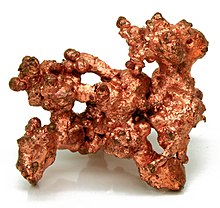Week 3b Chemistry - Copper
Copper (Cu)
Copper's atomic number is 29. Like Cr, it's electron configuration is one of the "exceptions" to the general rule (hund's rule, actually). Cu's electron configuration is written 1s22s22p63s23p64s13d10 instead of 1s22s22p63s23p64s23d9. Here's a great tutorial that explains why.
Pure Copper is orange-red in color

Copper is in Group 11 of the periodic table, and is a d level element. It is a soft, malleable, and ductile metal. Ductility is a measure of a material's plasticity, so Cu is described as being highly plastic. Humans have been using Cu in one way or another for over 10,000 years, and it was essential to the Bronze Age (copper + tin = bronze). Nowadays, it plays a dominant role in the electrical wire industry (Cu is highly conductive).
Cu is an essential trace element in our biology, and plays an important role in proper liver function. Wilson's disease is a rare genetic disorder in which copper builds up in the body, mainly affecting the liver and brain. Cu is also often used in agriculture for its fungicidal properties.
In alchemy, Cu is associated with Venus and Taurus. Recently, some modern day alchemists in China have converted Cu into gold (a gold that isn't gold exactly, but functions as gold on an atomic level - functional gold, so to speak). Check it out here.

Comments
Post a Comment